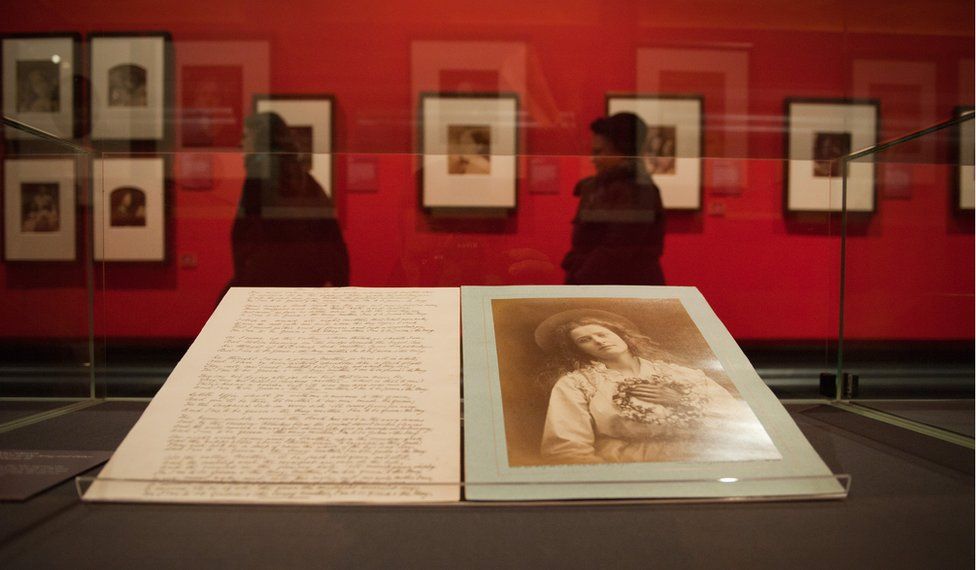Julia Margaret Cameron at the V&A
- Published

Julia Margaret Cameron first exhibited her work at the Victoria and Albert Museum 150 years ago and now to mark the bicentenary of her birth, more than 100 of her prints are back on show.
The photographs are drawn from the museum's own collection and elsewhere, and comprise both her best known pictures and some not seen before.
Cameron's rise to photographic star was late in her life. She was nearly 50 when she was given a camera for her birthday and set about becoming one of the most important photographers of the 19th century, and indeed arguably of all time.
She was born in Calcutta in 1815 to well-to-do parents, her father an official of the East India Company and her mother descended from French aristocracy.
But it was the British astronomer Sir John Herschel who introduced her to the then new invention of photography. They met while she was in South Africa convalescing and he was there to study the skies of the southern hemisphere.
After marrying she moved with her growing family to the Isle of Wight where many of her portraits of the giants of that time were taken. The family was very well connected and her subjects included leading scientists, poets and artists.
As well as working at her home in what she called a "fowl house" that was converted to a studio in 1968, she was given the use of a couple of rooms at the museum, then called The South Kensington Museum.
Marta Weiss, the curator of the exhibition calls Cameron the Museum's first artist in residence.
As well as portraits Cameron also like to create images of historic scenes and to create allegorical images, sometimes enlisting the help of her friends and staff who she would dress up and pose to suit her needs.
Cameron's technique was criticised by some at the time, even calling her work "slovenly". Poorly coated plates, thumbprints and other marks on the pictures all of which contributed to that analysis.
Yet her search and belief in photography as an art form, rather than just a process, became her strength.
An article in 1866 called her the first person to see her mistakes as successes. It continued: "..... and henceforward to make her portraits systematically out of focus".
Weiss said that other photographers would focus their lens until the image looked sharp, but Cameron would focus until it looked beautiful. It is hard to argue with that.
One very interesting set of pictures on display are a set of recently discovered pictures that were owned by her friend and mentor the painter and sculptor George Frederic Watts. Cameron was worried about cracks appearing on some her negatives and sent them to him. He had told her to send "defective unmounted impressions" rather than "valuable mounted copies".
According to Weiss this is Cameron at her most experimental, with traces of the photographic process on the plate, "flaws at most extreme".
Yet these were never intended to be published or exhibited, and the recent realisation of this allows us to read them in a different light.
Cameron saw some of her work as having commercial possibilities. One of her projects was to photograph her neighbour, Alfred, Lord Tennyson's Idylls of the King, something she hoped would make her some money, though in the end that was not the case.
In 1875 the Camerons moved to Ceylon to live on their coffee plantation and her photography effectively came to an end, though there is one picture on show from that time. Of course by then she was 60 and her husband 80. She died in 1879.
Cameron was a photographic pioneer who followed her heart, and produced pictures that spoke to the viewer capturing the essence of the sitter, perhaps more so than anyone has managed since.
The pictures might be from the 19th century, but there is a link to the present whereby visitors can take their own photograph in Cameron's style and share on social media using the hashtag: #VictorianMe
Julia Margaret Cameron at the V&A, supported by The Bern Schwartz Family Foundation, runs from 28 November - 21 February 2016.
Next door to the V&A The Science Museum is also showing work by Cameron. Julia Margaret Cameron: Influence and Intimacy runs until 28 March and comprises 94 original prints created between 1864 and 1867, alongside a dozen rare prints made by Cameron in the final years of her life spent living in Ceylon.